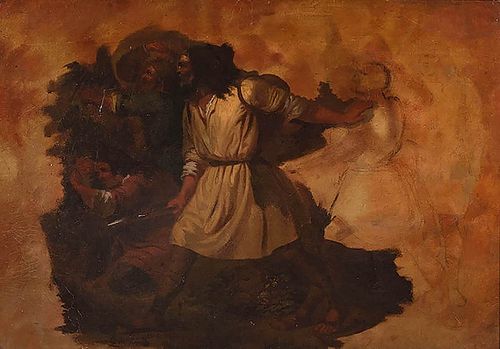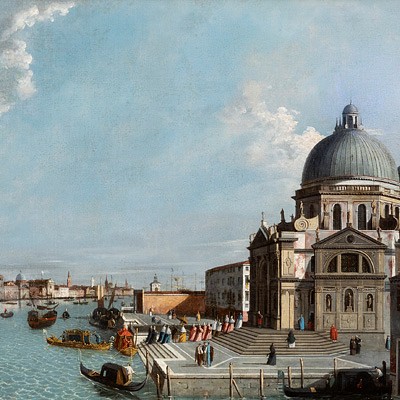MARIÀ FORTUNY MARSAL (Reus, Tarragona, 1838 - Rome, 1874). "The attack. Sketch ”, ca. 1853. Oil on cardboard. Attached report issued by the expert
Lot 36
About Seller
Setdart Auction House
Carrer Aragó 346
Barcelona
Spain
Setdart Subastas was born in 2004 and is currently the first online art auction in Spain with solidity, prestige and reliability guaranteed by our more than 60,000 users. Setdart has a young, dynamic and enterprising team ready to successfully manage the purchase and sale of art works through custom...Read more
Categories
Estimate:
EUR€12,000 - EUR€15,000
$13,043.48 - $16,304.35
Absentee vs Live bid
Two ways to bid:
- Leave a max absentee bid and the platform will bid on your behalf up to your maximum bid during the live auction.
- Bid live during the auction and your bids will be submitted real-time to the auctioneer.
Bid Increments
| Price | Bid Increment |
|---|---|
| EUR€0 | EUR€10 |
| EUR€200 | EUR€25 |
| EUR€500 | EUR€50 |
| EUR€1,000 | EUR€100 |
| EUR€3,000 | EUR€200 |
| EUR€5,000 | EUR€500 |
| EUR€10,000 | EUR€1,000 |
| EUR€20,000 | EUR€2,000 |
| EUR€50,000 | EUR€5,000 |
About Auction
By Setdart Auction House
May 18, 2021
Set Reminder
2021-05-18 09:30:00
2021-05-18 09:30:00
America/New_York
Bidsquare
Bidsquare : Classics XIX and XX
https://www.bidsquare.com/auctions/setdart-auction-house/classics-xix-and-xx-6961
The next 18th May there will be a 19th and 20th Century Classics Auction at Setdart.com There will be a select repertoire of important artists such as Carlos Cruz Diez, Luis Feito, Joan Miró, Fernando Botero, Josep Llimona, Salvador Dalí among others. Setdart Auction House sofia@setdart.com
The next 18th May there will be a 19th and 20th Century Classics Auction at Setdart.com There will be a select repertoire of important artists such as Carlos Cruz Diez, Luis Feito, Joan Miró, Fernando Botero, Josep Llimona, Salvador Dalí among others. Setdart Auction House sofia@setdart.com
- Lot Description
MARIÀ FORTUNY MARSAL (Reus, Tarragona, 1838 - Rome, 1874). "The attack. Sketch ”, ca. 1853. Oil on cardboard. Attached report issued by the expert Carlos González López. Presents the Barrachina-Ramoneda label on the back. Measurements: 32 x 45 cm; 55 x 69 cm (frame). Carlos González points out that it is the sketch of a composition of historical genre still of romantic tendency, where the theory of Milà Fontanals and the technique of Claudio Lorenzale, Fortuny's two teachers at the School of Fine Arts, can be appreciated. González goes on to indicate that the work must have been done for a subject on Catalan medieval history or a course exam at the School of Fine Arts in the winter of 1853, since technically it corresponds to the period when similar subjects were done, dated at that time. Fortuny began his training at the School of Municipal Art of Reus, and in 1850 he moved to Barcelona with his grandfather. There he continued his studies as a disciple of Domingo Talarn, and entered the School of Fine Arts, where he had as teachers Pablo Milá, Claudio Lorenzale and Luis Rigalt. At the same time he attends Lorenzale's private school, which will determine his inclination for romantic painting in this first stage. In 1858 he settles in Rome thanks to a scholarship, and attends the Chigi Academy. While he was there, the Diputación de Barcelona proposed him to travel to Morocco to paint the warlike encounters that were taking place in the area, which will give a total turn to his career. The light of Morocco and the exoticism of the place and its people led him to become interested in aspects totally unknown in his previous production. In 1860 he visited Madrid, where he visited the Prado Museum and became interested in the work of Velázquez and Goya. Shortly after, he began a trip to Europe and finally returned to Rome for good. He attends classes at the French Academy of Fine Arts at the Villa Medici, and in 1861 he visits Florence and comes into contact with the "macchiaioli". He returns to Morocco in 1862, and devotes himself to painting genre subjects in which he captures the movement through color and light. Back in Rome, he continued to focus on orientalist themes. Shortly after he travels to Paris and meets Adolphe Goupil, who will be his dealer from 1866. That same year he visits Madrid again and visits Toledo, where he discovers El Greco. In 1867 he exhibited in the studio of Federico de Madrazo, who became his father-in-law that same year. The following year he returned to Rome, and in 1870 his international fame was consolidated thanks to his exhibition in the Parisian gallery of Goupil. During these years he settled in Granada, in the Fonda de los Siete Suelos de la Alhambra, with the idea of tackling new themes with the greater freedom that commercial and critical success gave him. However, in 1872 he was forced to return to Rome, where he remained until his death. Mariano Fortuny is represented in the Prado Museum, the National Gallery in London, the Hispanic Society Museum in New York, the Palazzo Ruspoli in Rome, the Fine Arts Museums of Bilbao, San Francisco, Cincinnati and Boston and the National Art Museum of Catalonia, among many others.Attached report issued by the expert Carlos González López.
Condition
- Shipping Info
-
In-House Shipping
-
- Buyer's Premium



 EUR
EUR CAD
CAD AUD
AUD GBP
GBP MXN
MXN HKD
HKD CNY
CNY MYR
MYR SEK
SEK SGD
SGD CHF
CHF THB
THB
















